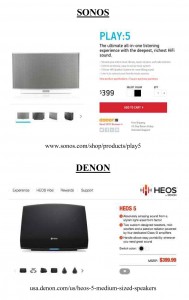
Congratulations Denon, your new HEOS system is so successful that wireless music monster Sonos has taken notice…and filed a lawsuit to stop it. It has been a open secret since we first learned of HEOS this past June that HEOS is meant to attack the same wireless music player market that Sonos essentially invented. Many have tried to take on Sonos…but none have come close to replicating the features and performance Sonos introduced to consumers. Until HEOS…
See more on this development. Will Denon fight? Or license?…
Sonos introduced their lawsuit against D&M Holdings, the D+M Group, D&M Holdings US, and Denon Electronics in a chit-chatty blog post on their website penned by Craig Shelburne, Sonos co-founder – and interestingly – General Counsel. In reading the blog post, it seemed to us that Shelburne attempted to convey that Sonos was taking the high-road…just trying to force competitors to innovate – not imitate.
Shelburne even posted the lawsuit for all Sonos blog readers (presumably customers) to read. In the lawsuit itself, Sonos asserts infringement on four of its patents. It also complains rather vigorously that Heos not only copied its products – but also copies…almost word-by-word…Sonos’ marketing.
Sonos goes on the offense…
Sonos asserts that even the name HEOS is “similar enough” to cause confusion. But they don’t stop there…Sonos notes the product designations (Denon’s HEOS 3, HEOS 5, HEOS 7 vs. Sonos’ PLAY:1, PLAY:3, PLAY 5) are copies of the Sonos product line.
But Sonos relies heavily on quotes from blogs, websites, and others to make many of their key points. The Sonos/HEOS name similarity? “[W]e can’t help but feel the similarity was deliberate,” says a quote from an Australian website. This seems to us a rather unconvincing argument.

Sonos relies on others to prove its points…
Is Denon marketing HEOS “directly” against Sonos? The lawsuit quotes the blog Digital Trends, which says in part: “With HEOS, Denon appears to be making little effort to hide its mimicry of the popular system.” Hmmmm…we’re not sure a judge is going to buy this.
Sonos includes screen shots of specific images from both the Sonos and the HEOS websites…and there’s no question – they look virtually identical. But with so many websites based on templates these days, it’s hard to imagine these designs opening up potential legal liability. Of course Sonos is looking at the whole picture, not just this one item – to suggest that HEOS is deliberately copying everything that Sonos does.
Sonos publishes patents to ‘accelerate innovation’…

Wow…that’s incredibly magnanimous. Does that mean others can easily access and copy their patents? Well, Sonos acknowledged that others will benefit from this easy access to their patents, but it is being made with “…an honorable caveat: use it to create differentiated products, rather than merely incorporating or copying our invention without our permission.”
Is this a clever lawyer trick?…
This sounds like a clever lawyer trick to us – and one that’s more of an un-altruistic warning to others. Actually, in view of what has transpired, it’s hard not to view that original post as an effort to lay groundwork for the suit filed yesterday. In the text of the lawsuit, Sonos noted:
15. On information and belief, Defendants had actual and/or constructive knowledge
of Sonos’s patents prior to the filing of this action. For instance, at a minimum, Defendants have been aware (or should have been aware) of Sonos’s patents in view of Sonos’s position in the industry (including its direct competition with Defendants), Sonos’s prominent display of its patents on Sonos’s website, and Sonos’s inclusion of a notice of its patents in Sonos’s product inserts and manuals. [Emphasis added]
However, manufacturers like Denon generally have offices full of lawyers who already have easy access to patent/trademark information globally. They are also usually pretty expert at knowing which patents are rock-solid…and which are kind of squishy. Sonos publishing patents on its website is more likely a warning…than an effort to stimulate innovation.
4 Sonos patents allegedly infringed upon…
We are neither engineers nor patent attorneys, however, we examined the four patents Sonos claims were infringed. The four are:
- US 8,788,080 – Titled Multi-Channel Pairing in a Media System. This patent largely covers the process of “grouping, consolidating, and pairing individual playback devices to create or enhance a multi-channel listening environment.”
- US 7,571,014 – Titled Method and Apparatus for Controlling Multimedia Players in a Multi-zone System. Much as you might surmise from the title, this patent largely covers “Techniques for controlling zone group and zone group characteristics such as audio volume in a multi-zone system…”
- US 8,588,949 – Titled Method and Apparatus for Adjusting Volume Levels in a Multi-Zone System. This patent pertains to “controlling a plurality of multimedia players, or simply players, in groups.”
- US D559,197 – Titled Control Strip for Electronic Appliances. This is a “design” patent that appears to describe a specific design of controls, buttons in a line or “strip” that Sonos has designed and used.
Are they enforceable?…
We have no idea just how enforceable these patents are, as they seem to describe processes that are pretty common for wireless systems. Especially the design patent for the layout of control buttons in a straight line. We’re pretty sure we’ve seen this concept on a lot of products over the years.
In any event, Sonos would likely argue that some of the processes described by their patents seem obvious now – but weren’t back when Sonos pioneered the concept of wireless multi-room audio systems. It would require a lot of research to verify if that is in fact the case.
Say one thing on their blog, another in their lawsuit…
Interestingly, in the blog post, Shelburne says: “We are not asking for a royalty or other license fee – we just want Denon to build an experience that isn’t copying ours.”
But in the lawsuit, Sonos asks the court for – among other things: “A judgment awarding Sonos all damages adequate to compensate for Defendants’ infringement of Sonos’s asserted patents, and in no event less than a reasonable royalty for Defendants’ acts of infringement, including all pre-judgment and post-judgment interest at the maximum rate permitted by law.”
Can Sonos get the court to stop HEOS?…
Perhaps more problematical for Denon, Sonos is requesting the court issue an injunction which would essentially put Denon’s HEOS division out of business. However, courts are typically reluctant to issue such injunctions in absence of evidence strongly backing the petitioner…and demonstrating real damages. Again, we’re not lawyers, but we don’t see that amount of teeth in this lawsuit.
More than likely, this lawsuit – much like most lawsuits over intellectual property (IP) – is a play to get just what Sonos’ blog claims they don’t want…royalties or some form of licensing fees. This is a very common tactic in IP disputes – lawsuits to force negotiations.
We have reached out to Denon to try to get more from their side of the story, but they have not responded to our requests prior to this report being filed.
See the full Sonos/HEOS lawsuit here…
Read the Sonos blog post here…




Leave a Reply